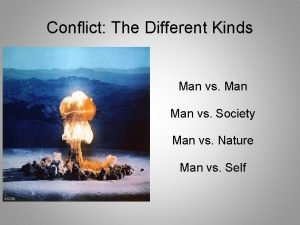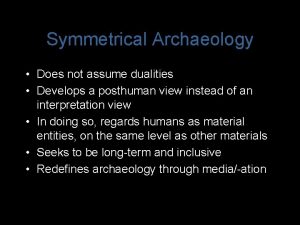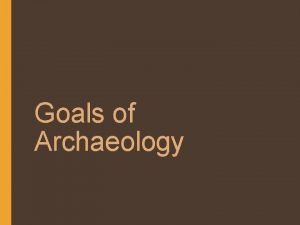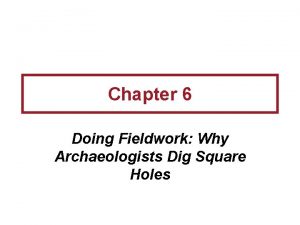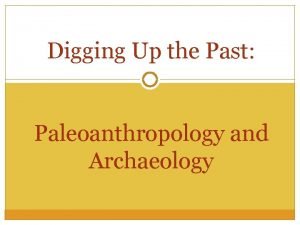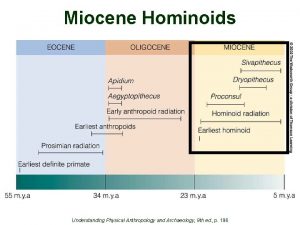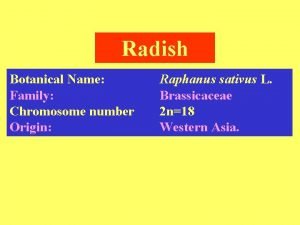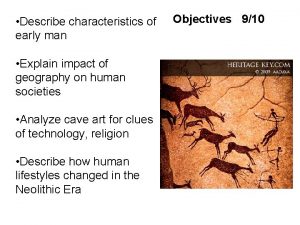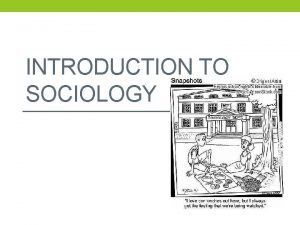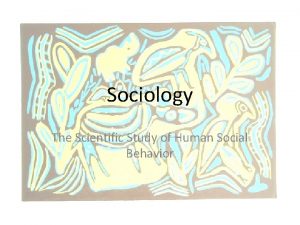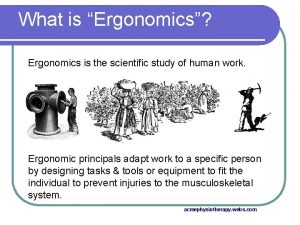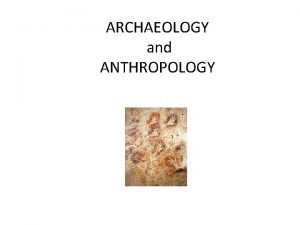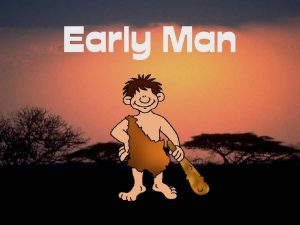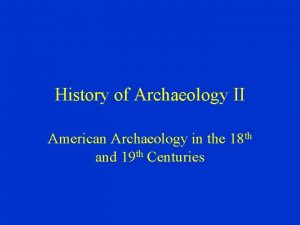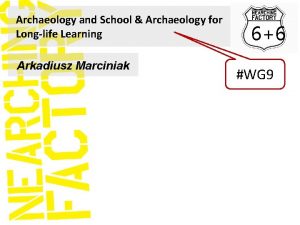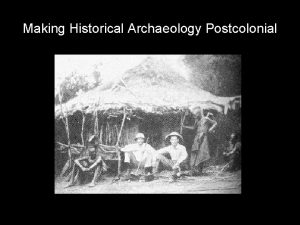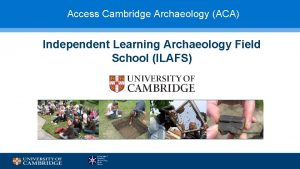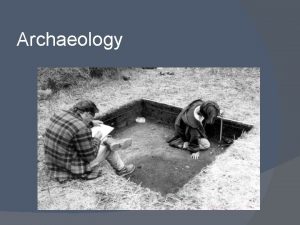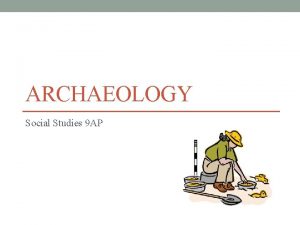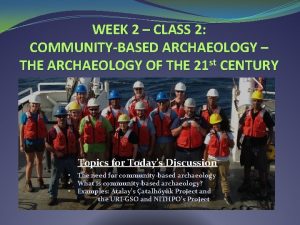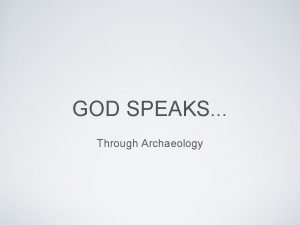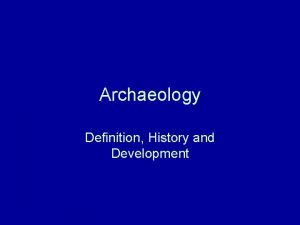Early Man Archaeology Archaeology is the scientific study





























- Slides: 29

Early Man

Archaeology • Archaeology is the scientific study of historic or prehistoric peoples and their cultures by analysis of their artifacts, fossils, settlements, and other such remains.

And… • Carbon dating! • Archaeologists measure the amount of carbon 14 (14 C) remaining in artifacts or fossils. The amount remaining tells the age of the item.

What, more than anything else… • Shaped the lives of early humans? • Their physical environment and the availability of food

Map of early humans Travels of Early Humans in Africa Humankind began in Africa and from there travelled to Eurasia, Australia, and the Americas

Paleolithic Era (Old Stone Age) 2 million B. C. E. - 10, 000 B. C. E. 1. Hunting & gathering societies 2. Nomads- people who travel from place to place in constant search of food and water 3. People traveled in small groups 4. Simple tools/weapons made of stone, bone & wood 5. Use of clothes & fire 6. Cave paintings found of animals 7. Animism- religion which involves worship of spirits in nature

What were Character-istics of Early Man? • Several Phases through many years • Hominids

Hominids • Australopithecines • Homo habilis • Homo erectus • Homo Sapien

Hominids • Walked upright • Opposable thumb

Australopithecus • Time Period and Location • 4 million to 1 million BCE • Primarily found in East Africa

• Appearance • Brain 1/3 size of modern humans • Long arms, but humanlike legs. • Capabilities and Skills • Bipedal: walked on two feet • Small social groups • Nomadic: traveled from place to place in search of food



Homo habilis • Time Period and Location • 2. 5 -1. 5 million BCE • Africa

• Appearance • Face like Australopithecus, but larger brain • Apelike arms • Capabilities and Skills • Scavenger: gathered plants and ate meat • First to use stone tools

START VIDEO @ 1: 40

Homo erectus • Time Period and Location • 1. 6 million 30, 000 BCE • Asia, Africa, perhaps Europe

fi • Appearance • Large brain • Fully upright stance • Capabilities and Skills • Developed new ways of using tools • Digging, scraping • First group to use FIRE • First to create spoken language


Homo sapiens neanderthalensis (Neanderthals) • Time Period and Location • 100, 000 to 400, 000 yrs ago • Africa, Europe, western Asia and the Near East

• Appearance • Brain larger than modern humans • Stocky and short-limbed • Capabilities and skills • Hunters and gatherers • Sophisticated tools (stone knives, spears) • Fire for protection and cooking • Burials for the dead • Nomadic


Homo sapiens (Cro-Magnons) • Time Period and Location • 100, 000 yrs ago to the present • Over time, found all around the world

• Appearance • Large brain • Relatively slender bones • Skills • Hunters and gatherers • Men: meat • Women: berries • Advanced tools using bone, antler, and ivy • Nomadic • Cave paintings


CLICK PICTURE FOR CAVE ART 101 VIDE 0

Old Stone Age • Known as the Paleolithic Age • Nomads • Hunters and Gatherers

New Stone Age • Known as the Neolithic Age • 8000 to 3000 BCE • Agriculture • Domestication of Animals

Major Advancement • What major advancement by man led to the advancement of civilization? • Settled agriculture • How did it happen? • Warmer climates led to more crop growth • Why did it help man? • Agriculture led to permanent settlements BIRTH OF FARMING VIDEO
 Man against man
Man against man Symmetrical archaeology
Symmetrical archaeology Goals of archaeology
Goals of archaeology Dr john oakes
Dr john oakes Archaeology is a messy business
Archaeology is a messy business Arbitrary vs natural levels archaeology
Arbitrary vs natural levels archaeology Archaeology
Archaeology Turkanopithecus
Turkanopithecus Archaeology
Archaeology Early cpr and early defibrillation can: *
Early cpr and early defibrillation can: * Tropical radish variety
Tropical radish variety Scientific name for root vegetables
Scientific name for root vegetables Information gathered during an experiment
Information gathered during an experiment How is a scientific law different from a scientific theory?
How is a scientific law different from a scientific theory? Characteristics of early man
Characteristics of early man Early man
Early man Medical device feasibility
Medical device feasibility Changfu wu fda
Changfu wu fda Fda early feasibility study
Fda early feasibility study Linguistics as a scientific study of language
Linguistics as a scientific study of language Social psychology is the scientific study of:
Social psychology is the scientific study of: Sociology major
Sociology major Scientific study of social behavior and human groups
Scientific study of social behavior and human groups The scientific study of trees
The scientific study of trees The scientific study of behavior and mental processes
The scientific study of behavior and mental processes Finished files are the result of years
Finished files are the result of years Good chair
Good chair Mendelian genetics vocab
Mendelian genetics vocab Hình ảnh bộ gõ cơ thể búng tay
Hình ảnh bộ gõ cơ thể búng tay
